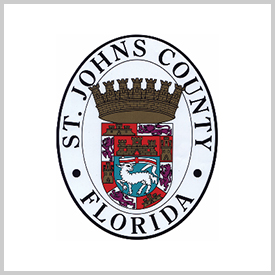
As Historic City News readers in St Johns County continue with post-Hurricane Matthew recovery, the Building Department is providing permitting information for residents who require home repairs due to the storm.
There is a potential for unlicensed, uninsured individuals to offer construction repair services without competence or expertise. To avoid having to pay for required construction twice, always request a copy of a state or local contracting license and proof of workers’ compensation insurance from anyone offering to do work on your home, and be sure to get a release for any work once its paid. Unlicensed individuals cannot legally secure permits which are essential to document the repairs and they often do not fulfill their agreements or contracts.
Contractors or unlicensed individuals found not complying with state and local contracting laws will be referred to the proper authorities for discipline. In most cases, work will require a permit complying with Florida Building Codes.
For properties located within a special flood hazard area, permitting must be in compliance with the Florida Building Code and the local flood plain ordinance. This includes Building Code requirements for substantial improvement cumulative over a five-year period.
These requirements may include items such as elevating the structure above the Base Flood Elevation plus freeboard or placing the structure on piling. An existing elevation certificate must be submitted to St. Johns County for any property requiring substantial improvements.
Properties located seaward of the Coastal Construction Control Line will be subject to all requirements regarding substantial improvement. They will also require a DEP permit from the state Department of Environmental Protection. Your coastal contractor can explain the limitations on temporary armoring and may apply for a temporary armoring permit. Requirements will include limits of construction, DEP permitting, construction details, and length of time it may remain in place.
However, some repair projects do not require permits, including the following:
Building
- One-story detached accessory structures used as tool sheds, storage sheds, or similar uses, provided the floor area does not exceed 120 square feet and it is not located within a special flood hazard area.
- Decks and slabs less than 30 inches in height and 200 square feet on residential lots that are on grade, not under a roof, and not located within a special flood hazard area.
- Fences of all material, except masonry, more than six feet in height.
- Retaining walls not over three feet in height measured from the bottom of the footing to the top of the wall.
- Sidewalks and driveways no more than 30 inches above adjacent grade, not over any basement or story below, and not part of an accessible route.
- Painting, papering, tiling, carpeting, cabinets, counter tops, and similar finish work within a single-family dwelling.
- Prefabricated pool associated with a Group R-3 occupancy.
- Swings, playhouses, and other playground equipment associated with detached single- and double-family dwellings.
- Window awnings supported by an exterior wall that do not project more than 36 inches from the exterior wall and do not require additional support of Groups R-3 and U occupancies.
- Roofing repairs not exceeding two squares.
- Siding repairs less than 100 square feet in area, including the area of door and window that are within the work space.
- Screen enclosures built under existing roofs of single-family dwellings with an exterior door.
- Gutters and downspouts.
- Pool re-marcite.
- Drywall repair below receptacles.
Electrical
- Minor repair work, including the replacement of lamps, or the connection of approved portable electrical equipment to approved permanently installed receptacles.
Plumbing
- The stopping of leaks in drains, or water, soil, waste, or vent pipes. If any concealed trap, drain, water, soil, waste, or vent pipe becomes defective and requires removal or replacement, such work will require a permit and inspection as outlined in the Florida Building Code.
- The clearing of stoppages or the repairing of leaks in pipes, valves, or fixtures.
- The removal and reinstallation of water closets, provided such repairs do not require replacement or rearrangement of valves, pipes, or fixtures.
- In-kind replacement of electric hot water heaters.
- Installation of water softeners.
Signs
- Changes shall not require a building permit, provided there are no changes to the cabinet, structure, or internal equipment.
For additional permitting or building services information, please visit or call 904.827.6800.




